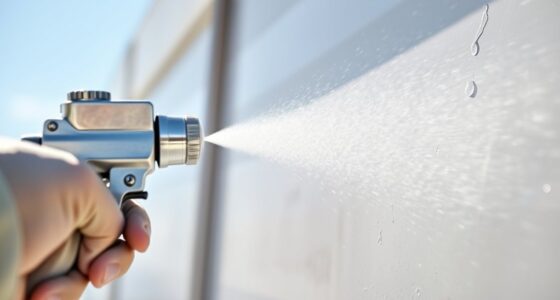To spray ceilings without drips, start by preparing your surface thoroughly and choosing the right spray equipment with suitable nozzles and pressure settings. Keep your spray gun 12-18 inches from the ceiling and use smooth, overlapping strokes for even coverage. Maintain a steady hand and consistent distance, adjusting your technique if you notice drips or uneven spots. Proper equipment care and environmental control help guarantee a flawless finish—continue exploring these tips to achieve professional results.
Key Takeaways
- Maintain a consistent spray distance of 12-18 inches from the ceiling to prevent over-application.
- Use smooth, overlapping strokes with steady speed to ensure even coverage and minimize drips.
- Adjust spray pressure appropriately based on paint viscosity to control flow and reduce runs.
- Regularly check the spray pattern for drips or uneven coverage and adjust distance or pressure as needed.
- Keep the spray gun perpendicular and at a steady height for uniform application and a drip-free finish.
Preparing Your Workspace and Materials
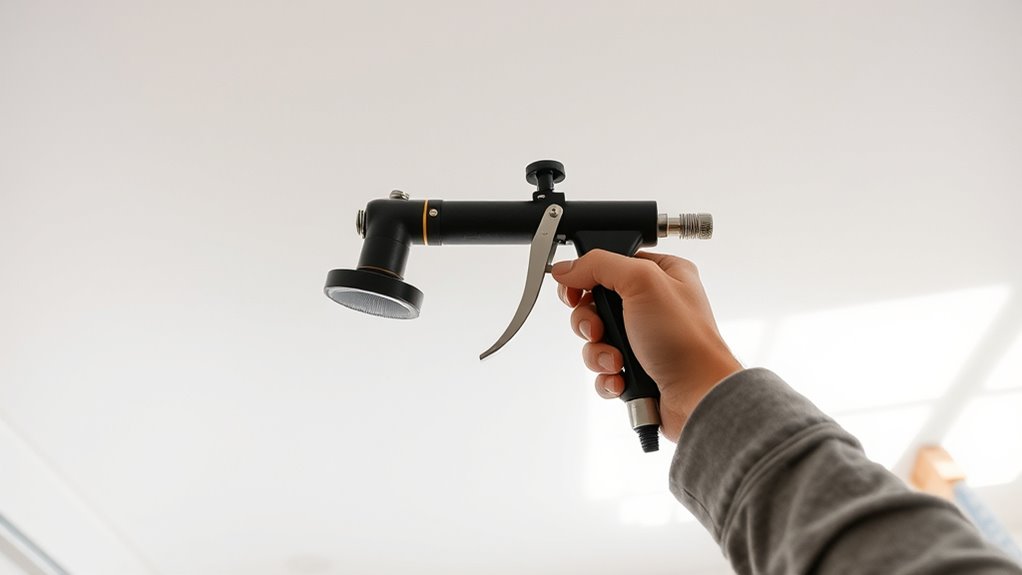
Before you begin spraying your ceilings, it’s essential to set up a clean, organized workspace. Proper work area setup helps prevent accidents and keeps your project efficient. Clear the area of furniture or cover it with drop cloths to protect against overspray. Gather all your materials beforehand, including paint, primer, and any masking supplies. Safety gear selection is crucial—wear goggles, a mask or respirator, and gloves to shield yourself from fumes and splatters. Make sure your ladder or scaffolding is stable and positioned correctly. Keep tools within easy reach and tidy up as you go to avoid clutter. A well-prepared workspace minimizes mess, enhances safety, and sets a solid foundation for a smooth spraying process.
Choosing the Right Spray Equipment
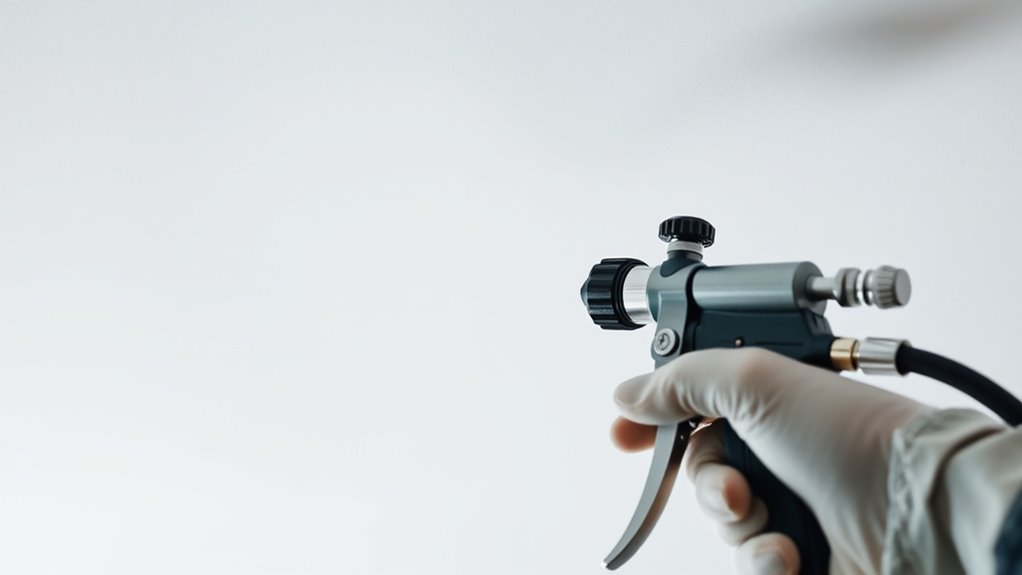
Selecting the appropriate spray equipment is crucial to achieving a drips-free ceiling finish. Your choice of spray nozzle affects the spray pattern and material flow, so pick a nozzle with the right size and type for your project. A narrower nozzle provides more control for precision work, while a wider one covers larger areas faster. Additionally, consider paint viscosity—thicker paints may need a nozzle with a larger orifice to prevent clogging and ensure smooth spraying. Adjust your equipment’s pressure settings accordingly to match the paint’s viscosity. Using the correct spray equipment minimizes overspray and drips, giving you a cleaner, more professional finish. Take the time to evaluate your paint’s thickness and select equipment that provides ideal atomization and coverage. Incorporating powerful persuasive words into your instruction can also motivate you to achieve a flawless finish more efficiently.
Proper Surface Preparation for a Flawless Finish

Starting with properly preparing your surface guarantees your paint adheres smoothly and results in a flawless ceiling finish. Clean the ceiling thoroughly to remove dust, grease, and debris that could hinder surface adhesion. Fill any cracks or holes with spackle, then sand smooth for an even base. Make certain the surface is dry before painting to maintain consistent paint consistency. Use a damp cloth to wipe away dust after sanding, preventing particles from mixing into the paint. Applying a primer improves adhesion and creates a uniform foundation for your topcoat.
- Clean thoroughly to remove dust and grease
- Fill and sand imperfections for a smooth surface
- Keep the surface dry for proper paint consistency
- Use a primer to enhance surface adhesion
Technique for Even and Controlled Spray Application

To achieve an even and controlled spray, keep your spray gun at a consistent distance from the ceiling. Use smooth, overlapping strokes to prevent streaks and uneven coverage. Adjust your spray pressure carefully to avoid drips and guarantee a uniform finish. Incorporating proper technique can further improve the quality of your application and ensure a professional-looking result.
Maintain Consistent Distance
Maintaining a consistent distance between your sprayer and the ceiling is essential for achieving an even, drip-free coat. When you keep the right distance, the spray angle remains steady, preventing uneven coverage or runs. Use the correct nozzle size to control flow and atomization, which helps uphold this distance comfortably. A too-close spray can cause thick drips, while too far reduces coverage. Additionally, understanding Kia Tuning options can help you optimize your vehicle’s aesthetic modifications for a more personalized finish.
- Keep the sprayer at the same height throughout the process
- Adjust your grip to maintain a steady hand
- Watch the spray pattern to ensure consistent coverage
- Adjust nozzle size if needed for better control
Use Smooth, Overlapping Strokes
Using smooth, overlapping strokes is key to achieving an even, controlled spray when painting ceilings. This technique guarantees consistent coverage and minimizes drips. Focus on maintaining proper brush techniques by keeping your movements fluid and steady. Adjust your paint consistency so it’s neither too thick nor too thin, helping create a smooth application. To enhance your technique, follow these guidelines:
| Technique | Tip | Result |
|---|---|---|
| Overlap each pass | Slightly overlap previous strokes | Even coverage, fewer streaks |
| Maintain a steady speed | Avoid rushing or slowing down | Consistent spray pattern |
| Use consistent pressure | Keep spray pressure uniform | Prevents drips and runs |
Mastering these aspects leads to a professional finish with minimal drips. Additionally, understanding the importance of contrast ratio can help you evaluate the quality of your projected images, ensuring a visually satisfying result.
Adjust Spray Pressure Carefully
Adjusting your spray pressure carefully is essential for achieving an even, controlled ceiling coat. When you adjust pressure properly, you prevent drips and uneven coverage. Start by setting your spray pressure to a moderate level—too high causes overspray, too low results in streaks. Consistently adjusting pressure ensures a smooth finish. Keep these tips in mind:
- Test spray pressure on a scrap surface before starting
- Adjust pressure gradually for fine control
- Maintain steady pressure during spraying
- Watch for signs of over- or under-pressurization and tweak as needed
- Monitoring spray pressure throughout the process helps maintain consistent coverage and prevents common issues like drips.
Managing Spray Distance and Movement
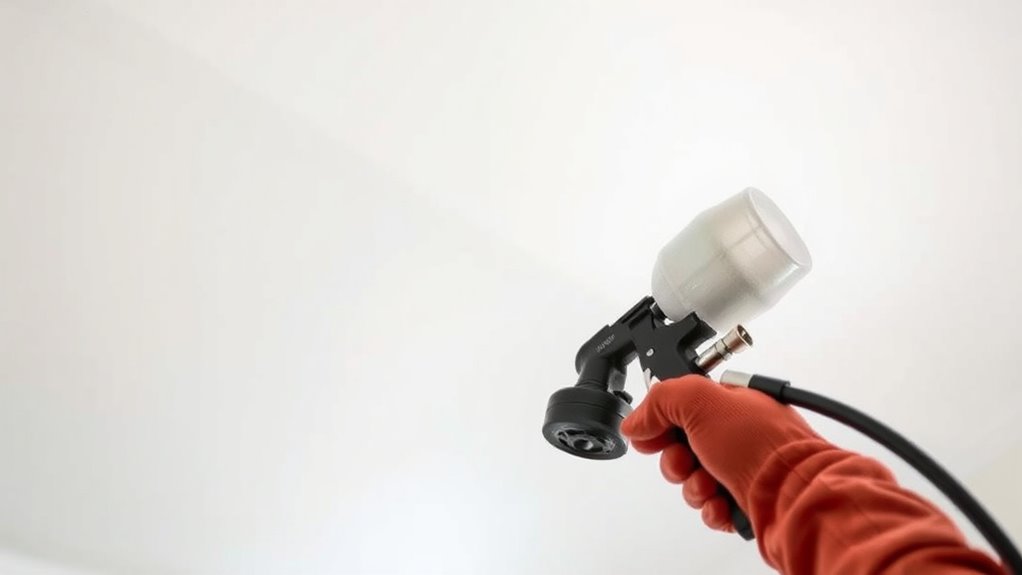
To prevent drips and achieve a smooth finish when spraying ceilings, controlling your spray distance and movement is essential. Keep the spray nozzle about 12-18 inches from the surface, maintaining a consistent spray angle to ensure even coverage. Be aware of wind influence; strong gusts can cause uneven application or overspray. Move your arm steadily in a consistent, overlapping pattern—side to side or in a cross-hatch—to avoid buildup and drips. Proper GMC tuning techniques can also help optimize your project outcomes.
Tips for Preventing Drips and Runoff
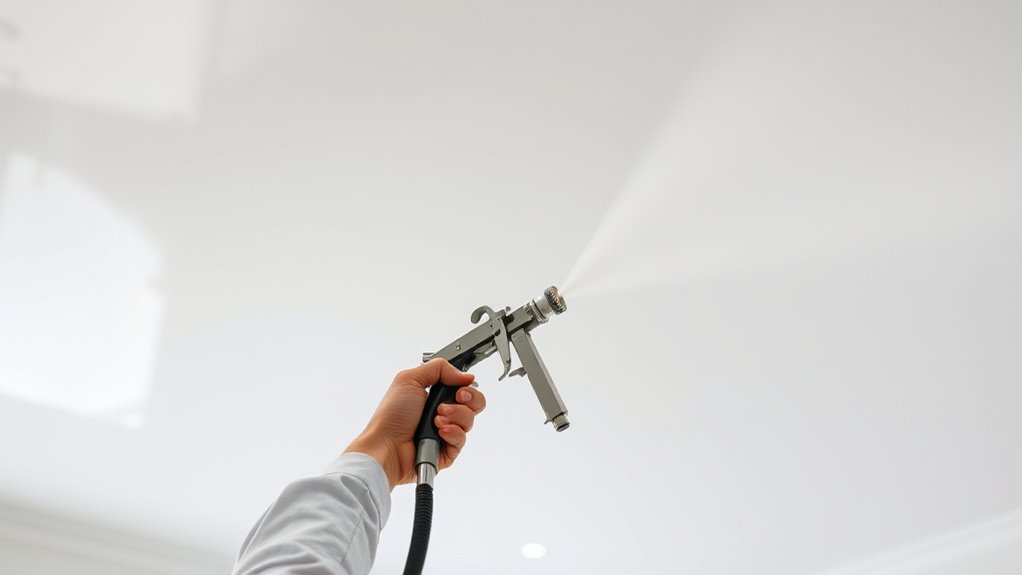
To prevent drips and runoff, keep your spray gun at the right distance from the ceiling. Make sure you’re controlling the spray pressure to avoid excess paint buildup. These simple adjustments can make a big difference in achieving a smooth, drip-free finish. Additionally, understanding precious metals market trends can help you plan your painting schedule during optimal conditions for best results.
Maintain Appropriate Spray Distance
Maintaining the correct spray distance is essential for preventing drips and runoff when spraying ceilings. Keep the spray gun about 12 to 18 inches from the surface, adjusting as needed for your paint type and ceiling height. Too close, and you risk excessive paint buildup; too far, and the spray becomes uneven. Use proper brush techniques to smooth out edges and avoid over-application. Ensure your paint is well mixed to maintain consistency and avoid splatters or thin spots. Consistent distance helps control the amount of paint applied, reducing drips. Remember to move steadily to maintain even coverage, and periodically check your spray pattern to prevent runs. Adjust your distance if you notice uneven paint distribution or dripping, guaranteeing a smooth, drip-free finish. Additionally, understanding the essential oils that support your painting environment, such as lavender for calming or eucalyptus for respiratory comfort, can enhance your overall project experience.
Control Spray Pressure Properly
Controlling spray pressure is key to preventing drips and runoff during ceiling painting. You need to guarantee your pressure gauge accuracy and spray nozzle calibration are spot-on. Use a pressure gauge to monitor your spray gun’s pressure regularly, adjusting as needed. Proper calibration helps maintain consistent spray and prevents excess buildup that causes drips. Keep the following in mind:
| Tip | Action | Result |
|---|---|---|
| Check pressure gauge | Confirm accuracy before starting | Reliable readings |
| Adjust spray pressure | Set to manufacturer recommended levels | Smooth, even spray |
| Calibrate spray nozzle | Test spray pattern and adjust if needed | Consistent coverage |
| Monitor pressure during work | Recheck periodically | Prevents pressure fluctuations |
| Use proper equipment | Ensure gauge and nozzle are in good condition | Accurate control |
Proper pressure control results in drip-free ceilings and a professional finish.
Cleaning and Maintenance of Your Spray Equipment

Regularly cleaning your spray equipment guarantees it performs at its best and prevents clogs or drips during application. After each use, thoroughly flush out paint or coating residues, paying attention to nozzles and filters. Check and replace air filtration components to ensure consistent spray quality. Always wear safety gear, like gloves and goggles, to protect yourself during cleaning. Keep your equipment dry and store it in a safe, dry place to prevent rust and damage. Regular maintenance also involves inspecting hoses and seals for wear or leaks. Proper cleaning and upkeep extend your equipment’s lifespan and ensure a smooth, drip-free finish every time. Automation technologies can also assist in scheduling and tracking maintenance routines.
Frequently Asked Questions
How Can I Avoid Paint Mist and Overspray in the Room?
To avoid paint mist and overspray, you should start by covering furniture and floors with drop cloths. Use masking tape to seal edges and protect walls or fixtures. Keep your spray gun at the right distance and move smoothly to prevent excess mist. Wearing a mask and goggles helps keep you safe from overspray, and working in a well-ventilated area minimizes lingering paint particles in the room.
What Types of Paint Are Best for Ceiling Spraying?
Choosing the right paint for ceiling spraying is like selecting the perfect brushstroke in a masterpiece. You’ll want a latex or acrylic paint for excellent paint durability, easy application, and quick drying. These types also help with color matching, ensuring a seamless look. Opt for low-VOC formulas to reduce fumes and overspray. Your goal is smooth coverage without drips, so select a quality paint that balances durability with ease of use.
How Long Should I Wait Between Coats for Optimal Results?
You should wait about 2 to 4 hours between coats, depending on the paint type and room conditions. This drying time allows the paint to solidify properly, reducing the risk of drips and uneven finish. Always check the manufacturer’s recommendations, as some paints may need longer to dry fully. Rushing this process can compromise the final look, so patience ensures a smooth, durable coat.
Can I Spray Ceilings in High-Humidity Environments?
Yes, you can spray ceilings in high-humidity environments, but humidity management is key. High moisture levels can cause uneven paint and drips. To improve results, use ventilation strategies like fans and dehumidifiers to reduce humidity. Confirm the air is dry and the temperature is stable before spraying. Proper humidity control helps the paint dry evenly, preventing drips and ensuring a smooth, professional finish.
What Safety Precautions Should I Take During Spraying?
Think of spraying ceilings like traversing a tightrope—you need balance and safety. Always wear protective gear like masks, goggles, and gloves to guard against fumes and splatters. Use proper ventilation strategies, such as opening windows and using fans, to keep fumes at bay. I once overlooked safety gear and ended up with a headache—lesson learned! Prioritize safety to guarantee a smooth, drip-free finish without health risks.
Conclusion
Mastering the art of spraying ceilings without drips can save you time and frustration. Did you know that proper technique reduces paint waste by up to 20%? By following these tips and maintaining your equipment, you’ll achieve a smooth, professional finish every time. Remember, patience and preparation are key. With practice, you’ll enjoy flawless ceilings and efficient results, making your DIY projects more satisfying and less messy. Happy spraying!



